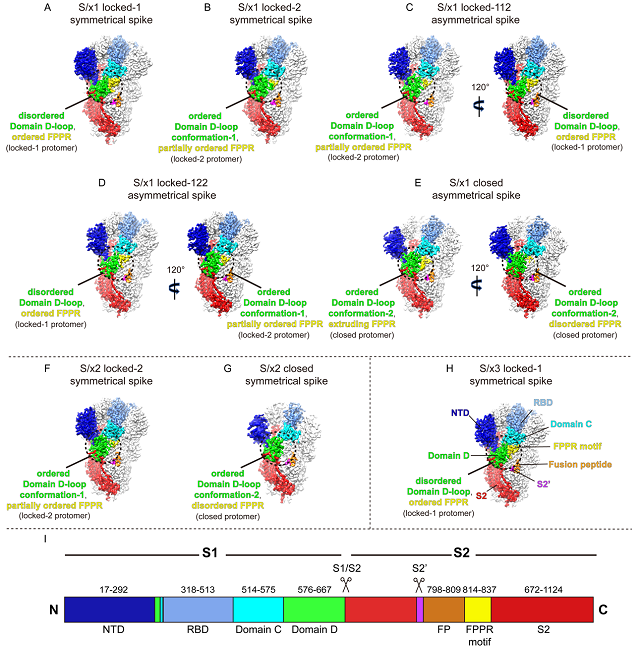Research reveals conserved features between SARS-CoV-1 and SARS-CoV-2 spike proteins
A team led by Professor XIONG Xiaoli, Professor HE Jun and Professor CHEN Ling from the Guangzhou Institutes of Biomedicine and Health of the Chinese Academy of Sciences introduced designed disulfide bonds into the SARS-CoV-1 spike (S) protein to allow imaging of previously unobserved rare conformations by cryo-electron microscopy (cryo-EM). They found that rare SARS-CoV-1 S conformations share parallel features with some conformations of SARS-CoV-2 and other Sarbecovirus S proteins and analyzed possible biological functions of these conserved features.
The study, entitled "Disulfide stabilization reveals conserved dynamic features between SARS-CoV-1 and SARS-CoV-2 spikes", was published in Life Science Alliance.
Coronavirus S protein binds virus receptor and mediates virus cell entry by promoting membrane fusion between virus and cell. It is the primary target of coronavirus vaccine development. Due to the SARS-CoV-2 pandemic, structure and function of the S protein have been a subject of intense research in recent years.
SARS-CoV-2 S protein exhibits complicated structural dynamics. Three distinct prefusion conformations for the SARS-CoV-2 S protein are identified: locked, closed and open. The locked conformation has a tightly packed structure with features incompatible with the RBD “up” open conformation which is capable of binding the ACE2 receptor. It is transient under neutral pH, while more stable in acidic pH. The instability of locked conformations may be the reason why they were not observed in previous structural studies of SARS-CoV-1 S protein.
The team previously developed three pairs of disulfide bonds (x1, x2, x3) for SARS-CoV-2 S protein with abilities to stabilize RBD "down" conformations including rare locked conformations. In this study, the researchers introduced these three pairs of disulfides individually into SARS-CoV-1 S protein and obtained purified SARS-CoV-1 S-x1, S-x2, and S-x3 proteins. The S-x3 protein was tested to immunize mice and found to induce strong neutralizing sera with comparable titers compared with unmodified SARS-CoV-1 S protein.
They imaged the engineered SARS-CoV-1 S proteins by cryo-EM and discovered that the engineered SARS-CoV-1 S proteins can adopt two different locked conformations: locked-1 (where three S protomers are in the locked-1 conformation) and locked-2 (where three S protomers are in the locked-2 conformation). Similar conformations have been reported for SARS-CoV-2 S protein.
The team also noticed asymmetric mixed locked conformations, namely, locked-112 (where two S protomers are in the locked-1 conformation and one is in the locked-2 conformation) and locked-122 (where two S protomers are in the locked-2 conformation and one is in the locked-1 conformation).
Furthermore, extrusion of Fusion Peptide Proximal Region (FPPR) was observed in S-x1 protein closed conformation structure, but not for the x1 disulfide stabilized SARS-CoV-2 S protein. This feature demonstrates conformation flexibility of FPPR. Moreover, different from SARS-CoV-2 S protein, low pH condition was unable to convert SARS-CoV-1 S protein into locked conformation. These results reveal similarities in structural conformations and differences in structural dynamics between SARS-CoV-1 and SARS-CoV-2 S proteins.
In summary, this study identified that the S protein of SARS-CoV-1 is similar to that of SARS-CoV-2, which can adopt two distinct locked conformations (locked-1 and locked-2). Together with the other observed S protein conformations, the study showcases the complex structural dynamics of the S proteins of SARS-CoV-1 and SARS-CoV-2.
Interestingly, to date, locked-2 conformation has been mostly observed for S proteins of other Sarbecoviruses. Structural analysis suggests that although differences exist between locked-1 and locked-2 conformations, both locked conformations utilize interactions located within domains C and D to rigidify the locked spike structures and to inhibit RBD motion. Conservation of mechanisms that inhibits RBD opening among Sarbecovirus S proteins in locked conformations suggests that locked conformations may play a conserved role in the lifecycle of Sarbecoviruses. The team proposed that the locked conformation may play a functional role in the virus assembly process, but this proposal requires further investigation to be confirmed.

Fig. Cryo-EM structures of engineered SARS-CoV-1 spikes in different conformations (Image by GIBH)
Contacts:
Xiong Xiaoli, PhD and He Jun, Ph.D
Guangzhou Institutes of Biomedicine and Health, Chinese Academy of Sciences
Guangzhou, China, 510530
Email: xiong_xiaoli@gibh.ac.cn; he_jun@gibh.ac.cn
Attachment Download:
-
Contact
-
Reference
-
Related Article